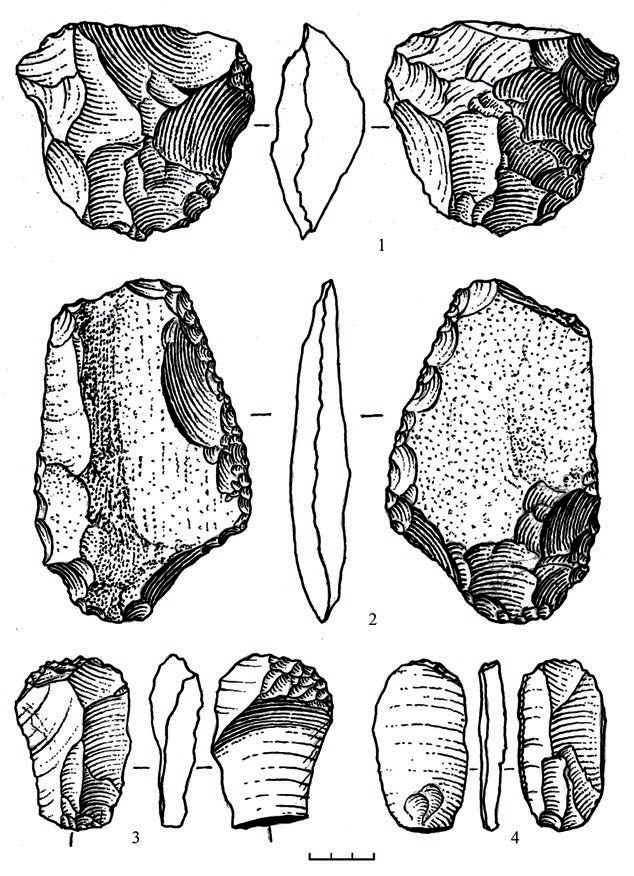Archaeological sites of the late Holocene in the upper Ishim river region (Northern Kazakhstan)
DOI:
https://doi.org/10.52967/akz2023.1.19.99.113Keywords:
archaeology, Northern Kazakhstan, Eneolithic, Vishnevka-8, Vishnevka-9, Turgenevka-15, site, artifact, biface, aleuritic tuffiteAbstract
The author describes the collections of stone artifacts obtained from the sites of the Eneolithic–Bronze Age in the upper Ishim river. At the stratified site Turgenevka-15, which is a closed assemblage, identified in the fossil soil layer of the Ishim high floodplain, was observed a special production of bifacial tools of various types. Radiocarbon dating of the soil layer with the finds showed that the site belongs to the 14th–13th centuries BC, which is not consistent with a modern idea about the age of the stone industry of the Early Bronze Age cultures in Kazakhstan and the wider steppe area in Eurasia. The archaeological material of the open sites of Vishnevka-8 and 9 includes samples of stone products typical of the Eneolithic and Early Bronze Age, as well as more archaic forms typical of the Paleolithic (one-sided platform cores, as well as close to Levallois, tools resembling cleavers and axes), which should be considered as vestigial elements of the Late Holocene stone industry. The issue of remnant elements in the stone industries of the late Holocene (and the Holocene in general) in Kazakhstan needs further study with the involvement of more materials.
References
Varfolomeev, V. V., Merts, V. K., Merts, I. V. 2021. In: Vestnik ENU. Ser. Istor. nauki. Filosofiya. Religiovedenie (Bulletin of the L.N. Gumilyov Eurasian National University. Historical Sciences. Philosophy. Religion Series), 1 (34), 36-48 (in Russian).
Voloshin, V. S. 2022. In: Onggar, A., Mamirov, T. B. (eds.). Margulanovskie chteniya–2022 (Margulan readings–2022). Almaty: Margulan Institute of Archaeology, 317-326 (in Russian).
Zaibert, V. F. 1993. Eneolit Uralo-Irtyshskogo mezhdurechiya (Eneolite of the Ural-Irtysh interfluves). Petropavlovsk: “Nauka” Publ. (in Russian).
Zaibert, V. F. 2009. Botayskaya kultura (Botay culture). Almaty: “KazAkparat” Publ. (in Russian).
Zdanovich, G. B., Ivanov, I. V., Khabdulina, M. K. 1984. In: Sovetskaya arheologiya (Soviet Archaeology), 4, 35-48 (in Russian).
Merts, V. K. 2005. In: Kiryushin, Yu. F. (ed.). Sohranenie i izuchenie kulturnogo naslediya Altaya (Preservation and study of the cultural heritage of Altay). Barnaul: Altajskij gos. un-t, S. 131-138. (in Russian).
Merts, V. K. 2008. Periodizatsiya i hronologiya golotsenovykh kompleksov Severnogo i Tsentralnogo Kazahstana po materialam mnogosloinoy stoyanki Shiderty-3: avtoref. dis. … kand. ist. Nauk (Periodization and chronology of Holocene complexes of Northern and Central Kazakhstan based on the materials of the multilayer Shiderty-3 settlement: abstract. dis. ... Candidate of Historical Sciences). Kemerovo: Kemerovo State University (in Russian).
Tarasov, P. E. 1992. Paleogeografiya stepnoy zony Severnogo i Tsentralnogo Kazahstana v golotsene: avtoref. dis. … kand. geol. nauk. (Paleogeography of the steppe zone of Northern and Central Kazakhstan in the Holocene: abstract. dis. ... Candidate of Geological Sciences). Moscow: Moscow State University (in Russian).
Tkachyov, A. A. 2003. In: Matveeva, N. P. (ed.). Ekologiya drevnih i sovremennyh obshchestv (Ecology of ancient and modern societies), vol. 2. Tyumen: Institute of the problem of Northern development SB RAS, 178-180 (in Russian).
Khotinskiy, N. A. 1984. In: Istoriya razvitiya pochv SSSR v golotsene (The history of the development of soils of the USSR in the Holocene). Pushchino, 23-24 (in Russian).
Boomer, I., Aladin, N., Plotnikov, I, Whatley, R. 2000. In: Quaternary Science Reviews, 19, 1259-1278.
Stuiver, M., Reimer, P. J. 1993. In: Radiocarbon, 35, 215-230. DOI: 10.1017/S0033822200013904

Downloads
Published
How to Cite
Issue
Section
License
Copyright (c) 2023 Валерий Степанович Волошин

This work is licensed under a Creative Commons Attribution-NonCommercial 4.0 International License.






